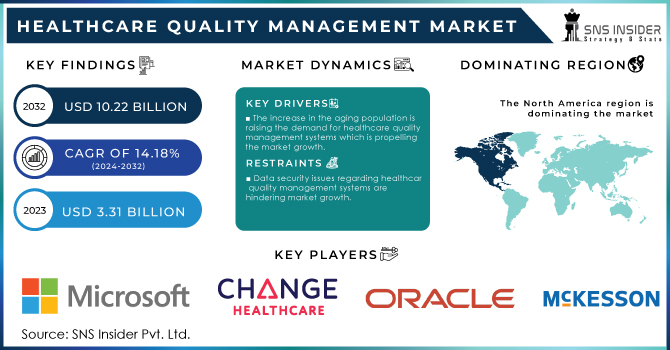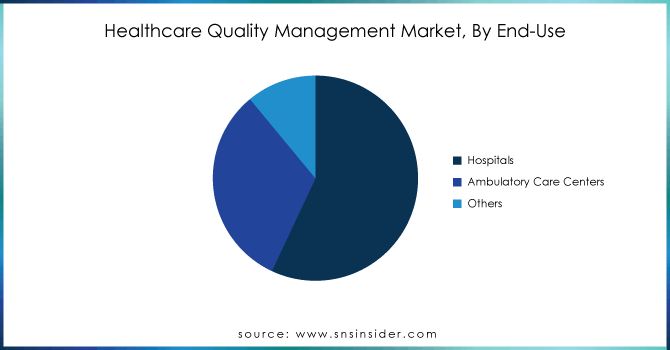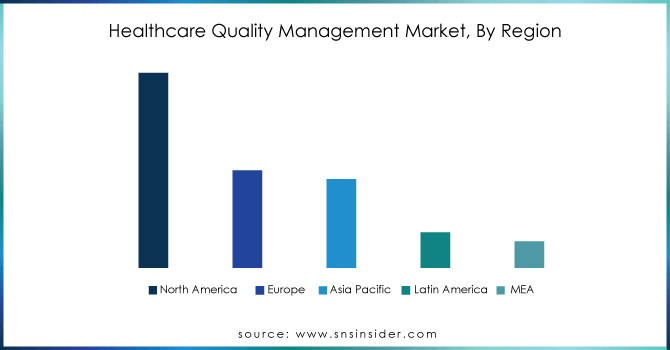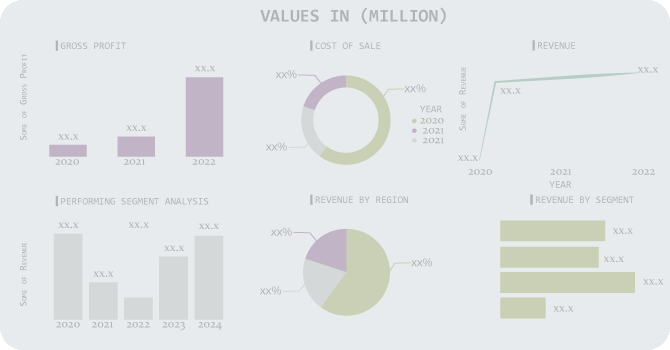Healthcare Quality Management Market Report Scope & Overview:

Get more information on Healthcare Quality Management Market - Request Sample Report
The Healthcare Quality Management Market Size was valued at USD 3.31 billion in 2023 and is expected to reach USD 10.22 billion by 2032 and grow at a CAGR of 14.18% over the forecast period 2024-2032.
The healthcare quality management market is growing at a steady rate owing to government mandates for the deployment of healthcare quality management solutions, an increasing amount of unstructured data in the Healthcare system, and rising pressure to curb healthcare costs. For example, the NCBI data published in January 2023 provides an overview of unstructured data in electronic health records (EHRs) for mortality prediction using EHR over the previous couple of years. The 80% of EHR is the unstructured data as per the same source. This unstructured data can be obtained from clinical notes in free-text, diagnostic imaging, and laboratory reports. As such, the vast majority of unstructured data is expected to spawn new technologies in analyzing them for valuable insights.
Additionally, product launches have been explored by the prevalent player owing to technological innovations that trigger market growth. In September 2021, for example, Florida authorized the use of automated pharmacy dispensing systems to deliver medication directly to patients in hospice settings, long-term care facilities, and prisons. In addition to this, increasing collaboration between major market players for the launch of advanced products is also fuelling growth as a large-scale implementation. As an example, in November 2021 Crothall Healthcare's Healthcare Technology Solutions (HTS) business launched a team quest - the only web-based Quality Management System platform specifically for teams developed with Intelex. This will, in turn, lead to the increased usage of these products by hospitals and thereby expected to drive healthcare quality management market growth. Due to the rapidly advancing technology used in healthcare, the cost of providing these services is increasing and thus under or developing nations struggle with performance-based indicators. As it is done by Governments in different countries worldwide to get a better quality of standard. These mandates are expected to drive the healthcare quality management market across the globe.
MARKET DYNAMICS:
KEY DRIVERS:
-
The increase in the aging population is raising the demand for healthcare quality management systems which is propelling the market growth
-
The huge volumes of unstructured data being generated by the healthcare industry are fuelling the demand for healthcare quality management systems.
RESTRAINTS:
-
Data security issues regarding healthcare quality management systems are hindering market growth.
-
The higher implementation costs of healthcare quality reporting systems can limit the adoption of healthcare quality management.
OPPORTUNITY:
-
Government mandates for healthcare systems to enhance quality as well as performance offering a lucrative growth opportunity for healthcare quality management systems.
-
Investment in R&D is responsible for the healthcare quality management system market growth during upcoming years.
KEY MARKET SEGMENTATION:
By Type
-
Business Intelligence and Analytics Solutions
-
Physician Quality Reporting Solutions
-
Clinical Risk Management Solutions
-
Provider Performance Improvement Solutions
In 2023, Business intelligence and data analytics solutions occupied the largest market share of over 51.03%. Also, business intelligence & data analytics software is projected as the fastest-growing segment during the forecast period. This is because of the upward trend in adoption levels of data analysis solutions, which allow health providers to process big chunks of information that highlight trends and patterns, enabling healthcare facilities to get insights delivering enhanced patient outcomes whilst cutting costs as well as operational efficiencies. BI and analytics solutions are valuable for examining clinical as well as operational data that can reveal opportunities to improve quality.
BI and analytics are gaining prominence in the healthcare industry with a focus on quality management since every patient wants to get cured. The BI tools can enhance the facility's performance and thus define new KPIs for developing a better monitoring mechanism to overcome those sets of constraints while ensuring accountability measures. Widespread use of these systems for enhancing performance in hospitals and other sites will provide additional impetus to this segment, which is projected to grow significantly. Compliance and adherence are increasingly becoming a priority, which has rendered the Clinical risk management solution segment to grow at the fastest rate.
By Mode of Delivery
-
Cloud-based
-
On-premises
-
Web Based
The cloud-based segment also leads the market and held the largest revenue share at 46.02% in 2023. This is because cloud-based approaches inherently provide the necessary flexibility to organizations, allowing them to adapt their software consumption quickly in line with evolving regulatory directives and operational demands. As you know, cloud-based systems also allow for much smaller upfront costs and data-sharing capabilities between members of the organization as well as remote access. These characteristics are changing the quality system and driving considerable market expansion within its cloud-based section.
Comparable acceptance among users is projected in the web-based segment much like cloud-based systems. On the other hand, market growth might not be on the same scale as cloud-based systems continue to take precedence for their ability to operate without constant internet connection. The web-based system requires an internet connection but can be accessed from anywhere, offering one of the only methods for a remote-accessible POS. This is anticipated to drive the web-based segment in the healthcare quality management market significantly.
On-premises software accounted higher revenue-generating segment during forth coming years, as it can deliver data security and control features that match quality management systems in healthcare organizations necessary for compliance-heavy industries such as the health industry where organizations had to take care of strict compliances related to healthcare quality management & also associated with all rules designed to cease any instances of a breach.
By Application
-
Data Management
-
Risk Management
-
Others
By End-Use
-
Hospitals
-
Ambulatory Care Centers
-
Others

Need any customization research on Healthcare Quality Management Market - Enquiry Now
REGIONAL ANALYSIS
North America accounts for a significant market share in 2023 of the healthcare quality management market. This can be majorly due to better reimbursement services and the government providing quality management facilities that are highly expected to propel the growth of the healthcare quality management market over forecasted years.
Processing of several product launches by the major players in this region boosted the adoption rate of these solutions across healthcare industries, thereby propelling the healthcare quality management market growth. In another example, in August 2021 Qualio launched design controls -- part of eQMS innovation to help medical device manufacturers deliver faster time-to-market by converging product development and quality management into a single workflow that automatically generates the comprehensive documentation needed for compliance and regulatory approvals.
Additionally, the NCBI article from February 2023 admits some of them died through medication errors in the US (around 7-9000 annual deaths). Additionally, hundreds of thousands more patients may experience an adverse reaction or other medication-related problem but fail to report it. As a result, there will be expanded medical errors in the healthcare systems and hence more adoption of quality management solutions among other factors. Therefore, based on the mentioned factors North America is expected to boost the healthcare quality management systems market by creating significant revenue share throughout the forecast period.

REGIONAL COVERAGE:
-
North America
-
US
-
Canada
-
Mexico
-
-
Europe
-
Eastern Europe
-
Poland
-
Romania
-
Hungary
-
Turkey
-
Rest of Eastern Europe
-
-
Western Europe
-
Germany
-
France
-
UK
-
Italy
-
Spain
-
Netherlands
-
Switzerland
-
Austria
-
Rest of Western Europe
-
-
-
Asia Pacific
-
China
-
India
-
Japan
-
South Korea
-
Vietnam
-
Singapore
-
Australia
-
Rest of Asia Pacific
-
-
Middle East & Africa
-
Middle East
-
UAE
-
Egypt
-
Saudi Arabia
-
Qatar
-
Rest of Middle East
-
-
Africa
-
Nigeria
-
South Africa
-
Rest of Africa
-
-
-
Latin America
-
Brazil
-
Argentina
-
Colombia
-
Rest of Latin America
-
KEY PLAYERS:
The competitive landscape based on the field is moderately fragmented for the healthcare quality management market as competition in this sector continuously raises acquisitions and mergers, providing product solutions that are customized to a wide variety of end-users than most traditional methods and expanding businesses into new commercial markets. Even though companies are spending billions to innovate new tools and platforms with enhanced features, a monetization policy. The key market players include Microsoft Corporation (Nuance Communications Inc.), Change Healthcare, Oracle (Cerner Corporation), CitiusTech Inc., McKesson Corporation, Dolbey Systems Inc., Medisolv Inc., RLDatix, Premier Inc., IBM & Other Players.
RECENT DEVELOPMENTS
-
In March 2023, in a step forward to reduce administrative burdens, Nuance Communications integrates its AI-powered virtual assistant solution with the EHR platform of vendor partner Cerner with voice documentation dictating through Dragon Ambient eXperience (DAX) —a conversational AI-based offering created by Nuance— Nashville, Tenn.-based health IT company Cerner plans to imbue its electronic health record platform with more intuitive and responsive information entry.
-
In January 2022, Francisco Partners collaborated with IBM for the acquisitions of its product portfolio which is healthcare data along with analytics assets from the Watson Health unit of IBM.
Dolbey Systems, Inc-Company Financial Analysis

| Report Attributes | Details |
| Market Size in 2023 | US$ 3.31 Billion |
| Market Size by 2032 | US$ 10.22 Billion |
| CAGR | CAGR of 14.18% From 2024 to 2032 |
| Base Year | 2023 |
| Forecast Period | 2024-2032 |
| Historical Data | 2020-2022 |
| Report Scope & Coverage | Market Size, Segments Analysis, Competitive Landscape, Regional Analysis, DROC & SWOT Analysis, Forecast Outlook |
| Key Segments | •By Type (Business Intelligence and Analytics Solutions, Physician Quality Reporting Solutions, Clinical Risk Management Solutions & Provider Performance Improvement Solutions) •By Mode of Delivery (Cloud-based, On-premises & Web Based) •By Application (Data Management, Risk Management & Others) •By End-Use (Hospitals, Ambulatory Care Centers & Others) |
| Regional Analysis/Coverage | North America (US, Canada, Mexico), Europe (Eastern Europe [Poland, Romania, Hungary, Turkey, Rest of Eastern Europe] Western Europe] Germany, France, UK, Italy, Spain, Netherlands, Switzerland, Austria, Rest of Western Europe]), Asia Pacific (China, India, Japan, South Korea, Vietnam, Singapore, Australia, Rest of Asia Pacific), Middle East & Africa (Middle East [UAE, Egypt, Saudi Arabia, Qatar, Rest of Middle East], Africa [Nigeria, South Africa, Rest of Africa], Latin America (Brazil, Argentina, Colombia, Rest of Latin America) |
| Company Profiles | Microsoft Corporation (Nuance Communications Inc.), Change Healthcare, Oracle (Cerner Corporation), CitiusTech Inc., McKesson Corporation, Dolbey Systems Inc., Medisolv Inc., RLDatix, Premier Inc., IBM among others |
| Key Drivers | •The increase in the aging population is raising the demand for healthcare quality management systems which is propelling the market growth •The huge volumes of unstructured data being generated by the healthcare industry are fuelling the demand for healthcare quality management systems. |
| RESTRAINTS | •Data security issues regarding healthcare quality management systems are hindering market growth. •The higher implementation costs of healthcare quality reporting systems can limit the adoption of healthcare quality management. |

